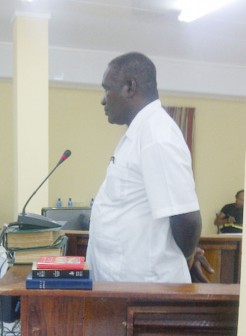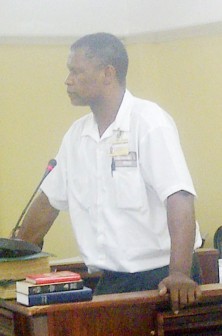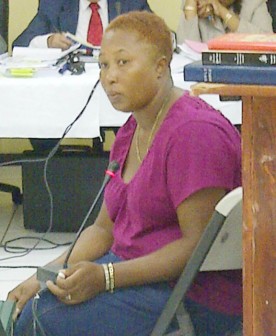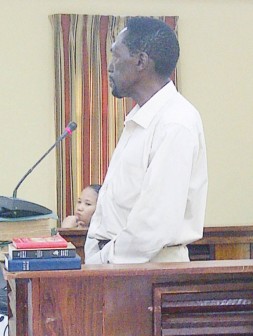Ron Lewis, a minibus operator was the latest witness to tell the Linden Commission of Inquiry yesterday that he saw police firing at protesters on July 18.
He was one of four persons to testify at the Supreme Court complex and the hearing also saw discussion on the possible appointment of an assessor to look into the losses suffered by Lindeners during the shooting that left three people dead.
“Perhaps we can recommend a judge or a retired judge with the relevant experience and who has the competence to be appointed as the assessor,” attorney Basil Williams told members of the commission yesterday, adding that a meeting should be called to further discuss the matter.

Commissioner KD Knight said that he would be prepared to hear about the structure that the attorney envisages and then the commission can make a recommendation. Williams affirmed that the experience of the Commission would greatly assist in the process.
Lewis, who was operating a bus on the day in question but managed to take several photographs, returned to the stand and said that he was shot with a pellet to the leg and was grazed near the eyes.
He had initially presented six photographs to the commission but when he returned yesterday, a flash drive holding about 40 to 60 photographs was accessed. The witness stated that he had no images of the protestors throwing missiles at the lawmen or any with the police discharging teargas or using their weapons. “I was running myself, I took pictures when the people settled down,” he said.
“Did you see the police holding their guns as though they wanted to fire at the crowd,” the witness was asked by Commissioner Knight. He responded in the negative. Instead, Lewis asserted that he saw the police shooting in the direction of the crowd.
“I saw them shooting at the crowd while I was running… they were at the side of me. I was trying to get into my bus. There is no photograph of them shooting but I saw it,” he maintained.

The commission of inquiry is examining the circumstances surrounding the shooting to death of Allan Lewis, Ron Somerset, and Shemroy Bouyea and the injury of several others near the Mackenzie-Wismar Bridge on July 18.
Confrontation
Also taking the stand yesterday was a staffer of the Mackenzie Hospital, Brian Clarkson, who is attached to the X-ray Department. He said that on the night of the shooting patients and their relatives had confrontations with the police even in the hospital and he found the cops to be wrong.
“There was this man who come in and groaning and making loud noise about they shoot this and they shoot that and they want to kill people and coming through, they (the police) said to him ‘come over leh we search’ and he say ‘search for what’ and he open his shirt. They (the police) just pull guns and I turn around and rebuke them by saying ‘how could you do such an action? There it is that this man is groaning, probably had someone dead or such… don’t they teach you psychology and such?’” the man recalled saying.
Audio
COI Hearing 19/10/12
He said that a short police officer dressed in brown responded to him. “His thing was the place is dark, they don’t have torchlight and they are out here and when the guy is opening his shirt, they couldn’t know if he had a weapon or not so the first action they have to do is protect themselves,” the witness said.

Before Clarkson was call-ed to the stand, attorney Peter Hugh, who is representing the Guyana Police Force, said he did not see the relevance of having this witness testify. “He does not add or subtract from anything that has already been said,” Hugh said as attorney Williams noted his disagreement with this.
Hole in my foot
Also giving evidence in the case was Yolanda Hinds who said she was injured to her leg as a result of the shooting and was unable to work for 28 days. “I was injured by gunshot. Got a hole in my foot… I got shot,” the woman said as she was seated. Though able to walk, the woman is unable to apply much pressure to her leg and so she could not take the witness stand and was seated throughout her testimony instead.
She said that although she did not receive a medical certificate from the Mackenzie Hospital she is aware of her doctor’s name, giving it as Dr. Stephenson.
Hinds said that she is employed at the Linden Hospital Complex and had to apply for sick leave and, as a result, suffered a loss of income. “When I went out to work, they tell me I can only have three months of gratuity and they take my allowance too. I didn’t get paid either,” she said.
Under questioning by Hugh, the woman said that she was going to her place of employment and was at the time crossing the Wismar-Mackenzie Bridge when she was shot. She said she was about 20 to 30 feet away when she observed the police discharging teargas. “I continued walking in the direction of the police. I didn’t really know wah going on, I was hustling to go to the hospital,” she said.

Kenneth Chance, a 64-year-old Albouystown resident who described himself as a human rights activist, said that he left Georgetown and arrived at Linden on July 18 around 9:30am. The man said he went to the Wismar end and met a peaceful protest and he was advised that they would be meeting someplace else.
“People were talking about the electricity bills, how it will affect them, police officers were in the midst seeing the march went on peacefully,” he said when asked what he observed upon his arrival. Chance said he addressed the protestors and spoke about the people’s “right to assemble and having problems within the human rights chapter”. He noted that this address was given sometime between 4pm to 4:30pm and there were other contributors, all sharing similar sentiments.
Chance said that he noticed several police officers, some dressed in brown clothes and others in black, amidst the people. He said he proceeded towards the police. When asked if the others joined him, the witness said “the rest were still a bit scared because the police begin to shoot teargas. That was the first thing they shot at us.”
He said that he observed about 16 or 17 police ranks in the direction from which the teargas was fired. “After the teargas was fired, they start to scatter the crowd because bullet come after,” he said, adding that this was around 5:30pm.
“People were running helter-skelter and the bullets started firing… Bullets fired shortly after teargas… could be about three minutes after and persons start scatter,” he told the commission.
Pointing out that he went “down in the valley” for safety reasons, the witness stated that he “had the privilege of being shot at in protest”. Attorney Williams asked the witness what he meant by privileged. “You said you were privileged to be shot at? You are talking in the context of your work as a human rights activist in different demonstrations you attended?”, he asked, receiving an affirmative answer.
Under questioning by Hugh, Chance said he had no knowledge of blockages nor does he remember the police attempting to clear logs from the roadways.








